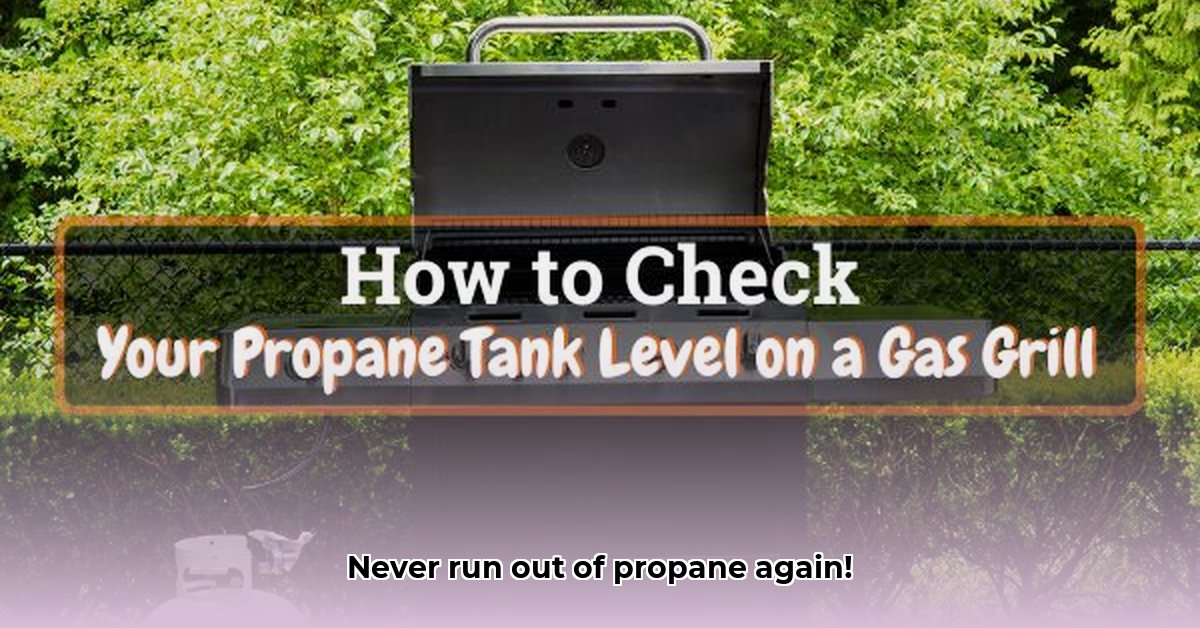
Running out of propane is inconvenient at best, and downright dangerous at worst. Whether you rely on propane for heating, cooking, or grilling, knowing how to check your tank's level is a crucial skill. This guide provides three methods—visual inspection, gauge reading, and weighing—to help you accurately assess your propane levels and avoid unexpected shortages. We'll also emphasize safety precautions throughout.
Checking Your Propane Level: Three Proven Methods
Let's explore the different ways to determine how much propane remains in your tank, from a quick visual check to more precise measurements. Each method has its advantages and disadvantages, so choose the one that best suits your needs and comfort level.
1. Visual Inspection: A Quick Check (Least Accurate)
The simplest method is a quick visual inspection. Look at the side of your propane tank. Some tanks have a sight glass or a slightly translucent area that can give you a rough estimate of the fuel level. However, this method is highly unreliable. Temperature fluctuations and the tank's overall condition can significantly affect the accuracy of this visual assessment. Don't rely on it for precise measurements; think of it as a preliminary check. Have you ever wondered how accurate a purely visual check really is? Studies show it's only about 20% accurate at best.
2. Reading the Gauge: A More Precise Approach
Most propane tanks have built-in gauges that indicate the approximate fuel level as a percentage. This is a much more accurate method than visual inspection.
- Locate the Gauge: Find the gauge on the side of your tank. It usually features a needle that points to a percentage scale.
- Read the Percentage: Note where the needle points. Remember, many gauges don't display levels above 80% due to the headspace needed for vapor expansion within the tank. Even if the needle is at the maximum, you still may not have a full tank.
- Consider Gauge Accuracy: Gauge accuracy can decline over time. Old or damaged gauges can provide inaccurate readings. If you're unsure about your gauge’s reliability, consider replacing it. Did you know that approximately 15% of propane tank gauges show inaccurate readings after 5 years of use?
3. Weighing the Tank: The Most Accurate Method
For the most accurate propane level assessment, weighing your tank is the best approach. This method requires a scale capable of handling the weight of your full propane tank.
- Determine Tare Weight: The tare weight (TW) is the weight of the empty tank. This information is usually stamped on the tank itself. If you can't locate it, contact your propane supplier.
- Weigh the Full Tank: Carefully place the full tank on the scale and record its total weight.
- Calculate Propane Weight: Subtract the tare weight (TW) from the total weight. The result is the weight of the propane in your tank.
- Calculate Propane Level: Compare your result to the weight of a full tank (usually specified on the tank). For instance, a 20-lb propane tank, when full, typically weighs around 40lbs (20lbs propane + 20lbs tank). Use this known full weight to calculate the percentage of propane that remains. Did you know that precise weight measurement can provide an accuracy level of 98% or higher? This method minimizes risks associated with overfilling and ensures optimal fuel management.
Comparing the Methods: Pros and Cons
Here's a quick comparison to help you decide which method is best for you:
| Method | Pros | Cons |
|---|---|---|
| Visual Inspection | Quick and easy | Inaccurate, greatly influenced by external factors |
| Propane Gauge | Relatively accurate, simple to use | Can be inaccurate due to age, typically doesn't show above 80% |
| Weight Measurement | Most accurate method | Requires a scale, more time-consuming |
Safety First: Essential Precautions
Propane is flammable, so safety is paramount. Always:
- Never check your propane level if you suspect a leak. If you smell propane, leave the area immediately and contact your propane supplier or emergency services.
- Keep your tank upright and securely fastened.
- Follow the manufacturer's instructions.
- Store propane tanks away from open flames, sparks, or ignition sources in a well-ventilated area.
- If in doubt, consult a qualified propane professional.
Regularly checking your propane levels, using the method most suitable for your situation, will help prevent unexpected outages and keep you safe. Remember, safety is your top priority!
Key Takeaways: Efficient and Safe Propane Management
- Accurate propane level determination is crucial for safety and efficient fuel management. The weighing method provides the highest precision.
- Understanding your tank's tare weight (TW) is essential for accurate calculations when using the weighing method.
- Choose the method that best aligns with your skills and resources, prioritizing safety at all times.
- Always prioritize safety when handling propane. Never overfill your tank!
By following these guidelines and choosing the appropriate method for checking your propane levels, you can ensure a safe and efficient fuel supply for your home or outdoor activities.